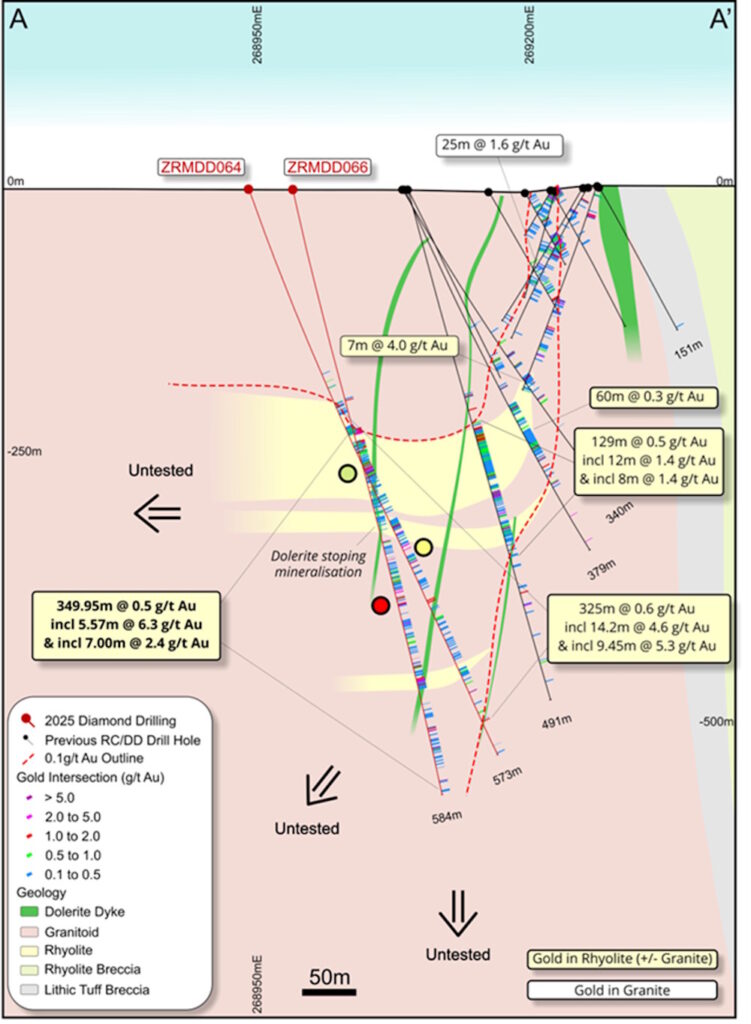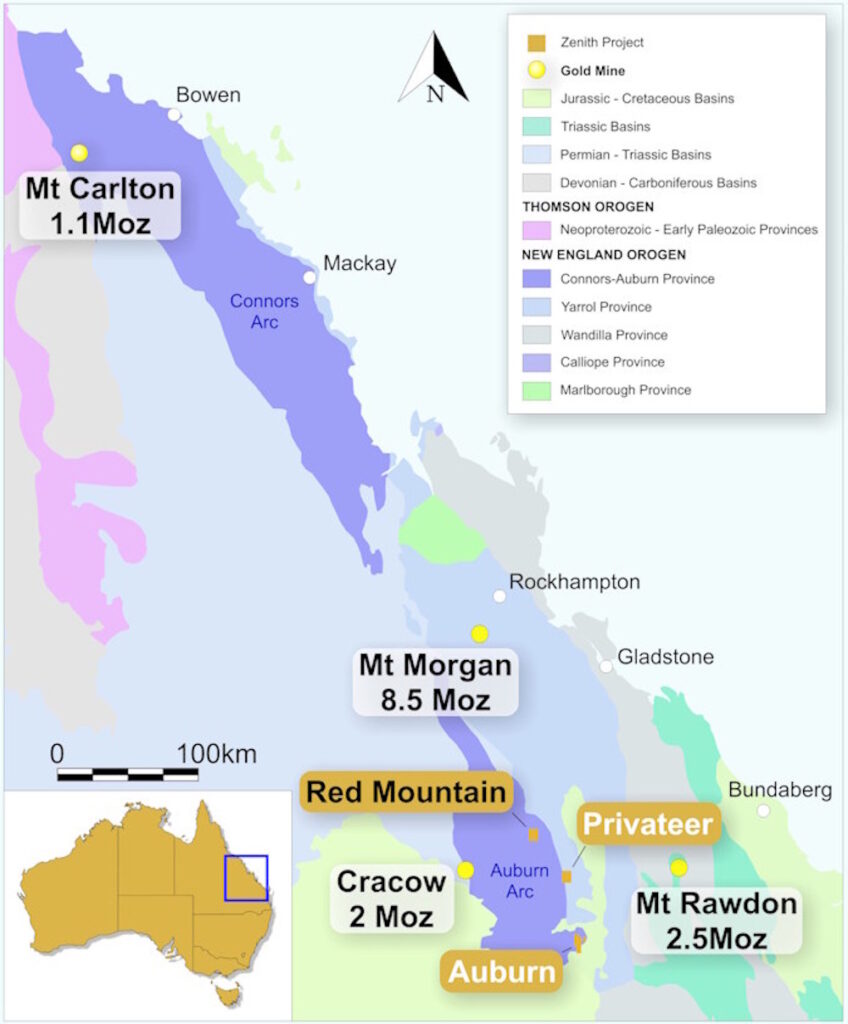Red Mountain
Gold Project (100%)
Overview
The 100%-owned Red Mountain is a virgin gold discovery by Zenith Minerals, located within Queensland’s highly endowed Auburn Arch — a region that hosts multiple major gold deposits and operating mines. The project benefits from sealed road access, grid power nearby, water, and a skilled local mining workforce.
Zenith also holds the nearby Auburn and Privateer prospects within the same geological corridor. Both display similar intrusive and alteration characteristics and are considered highly prospective for additional gold and copper mineralisation, supporting the broader district-scale potential.
Recent diamond drilling at Red Mountain has confirmed an expanding mineralised system with strong continuity and substantial vertical extent of gold mineralisation hosted within rhyolite sills and adjacent granite. Results support an Intrusion-Related Gold (IRG) model analogous to the world-class Mt Wright deposit. The system remains open to the west and at depth.
2025 drilling highlights
In October 2025, Zenith commenced a 4,000–5,000 m RC drilling programme (10–15 holes) to step out laterally and define shallow extensions across the upper rhyolite sill. Holes are designed for potential diamond tails to target deeper, higher-grade zones identified by recent diamond drilling.
- ZRMDD064 (final assays):
139.7 m @ 1.05 g/t Au from 225 m, within a broader 325.0 m @ 0.56 g/t Au from 214.9 m. Higher-grade internal zones include 14.2 m @ 4.62 g/t Au (incl. 2.0 m @ 21.03 g/t Au) and 9.45 m @ 5.29 g/t Au (incl. 2.1 m @ 21.15 g/t Au). Base-metal and silver pathfinders are elevated in places. - ZRMDD066 (final assays):
349.95 m @ 0.47 g/t Au from 232.05 m, including 5.57 m @ 6.32 g/t Au (with 3.12 m @ 10.16 g/t Au), plus 29.0 m @ 1.08 g/t Au from 375 m; 17.0 m @ 1.08 g/t Au from 466 m; and 39.15 m @ 0.48 g/t Au from 520 m. First visible gold at depth was logged within 0.5 m @ 19.8 g/t Au from 394.9 m, supporting the presence of a higher-grade core. - System geometry: Current drilling indicates the principal gold host is a flat-lying rhyolite sill, with mineralisation extending into the underlying granitoid. A second, lower rhyolite sill has also been identified; the system widens to the west and remains open at depth.
Geological model
- Mt Wright–style IRG system: Multi-element geochemistry shows elevated Zn-Pb-Ag associated with gold, consistent with outer-halo metal zonation in an IRG system. Vectors indicate increasing temperature/mineral intensity westwards and at depth, towards a higher-grade core.
- Continuity and scale: Drilling demonstrates broad mineralised widths with vertical continuity beyond ~530 m. The footprint widens westwards, and multiple untested zones remain between and below the rhyolite sills.
- Host geology & styles: Gold occurs within flat-lying rhyolite sills intruded into granitoid, as disseminated sulphides and quartz–carbonate–pyrite–arsenopyrite veining, plus sheeted micro-veins and breccia infill associated with silica–sericite–carbonate–chlorite alteration. Higher grades correlate with brecciation and complex sill–granitoid contacts.
Metallurgy
Previous test work indicates free-milling, non-refractory gold, with average recoveries of ~83% via conventional cyanide leaching and up to ~96% in low-arsenic samples, supported by strong gravity recoveries — pointing to straightforward processing pathways.
District & tenure
- Zenith controls ~95 km² (EPM 26384 plus a southern application) along a prospective corridor interpreted to focus emplacement of the Red Mountain intrusive system. Recent additional applications to the west and northwest expand tenure to ~120 km², securing strike extensions over key geophysical and geochemical targets linked to the main intrusive complex.
- The project is situated in a prolific mining jurisdiction with excellent infrastructure, logistics, and community support.
Next steps (near-term work programme)
- District-scale exploration ramp-up: Soils, rock-chips and targeted geophysics across the broader district to identify additional Red Mountain–style systems and prioritise new targets.
- 10–15 hole RC programme (underway): Testing lateral extents of the upper sill, collecting multi-element data for vectoring, and refining diamond-tail targets for the 2026 season.
- Geophysics: Extend IP coverage west to encompass open chargeability anomalies coincident with mineralised rhyolite; integrate with magnetics, mapping and geochemistry to rank deeper diamond targets.
- Wet-season activities (late 2025–early 2026): Systematic soil and rock-chip programmes across newly secured ground to define additional mineralised centres and refine future drill targets.
Previous exploration
Red Mountain’s exploration history includes a series of high-grade shallow intercepts and broad mineralised zones at depth, further supporting the Project’s potential as a large-scale IRG system. Shallow RC drilling has delivered the following high-grade gold intercepts (reported at a 0.3 g/t Au cut-off).
See ASX Releases 30 Nov 2020 & 14 Apr 2021
- 13 m @ 8.0 g/t Au from surface, including 6 m @ 16.7 g/t Au (ZRMRC001)
- 15 m @ 3.5 g/t Au from 57 m, including 2 m @ 22.4 g/t Au (ZRMRC019)
- 12 m @ 4.9 g/t Au from 102 m, including 6 m @ 9.4 g/t Au (ZRMRC021)
- 5 m @ 10.4 g/t Au from 67 m, including 1 m @ 49.9 g/t Au (ZRMRC023)
- 7 m @ 4.4 g/t Au from 63 m, including 1 m @ 19.3 g/t Au (ZRMCD041)
Deeper drilling in 2023 confirmed the continuity (ASX: ZNC -29-August 2023; 11-Nov 2024):
- 129 m @ 0.51 g/t Au + 11.9 g/t Ag from 225 m in (ZRMDD052; 0.1g/t Au cut-off), including: 12 m @ 1.36 g/t Au, and 9 m @ 1.24 g/t Au
2024 RC drilling campaign highlights (See ASX Release 20 Jan 2025):
- 23m @ 1.49 g/t Au from 48m, incl 2m @ 11.3 g/t Au from 55m (ZRMRC055)
- 4m @ 4.45 g/t Au from 122m incl 2m @ 8.11 g/t Au from 122m (ZRMRC056)
- 3m @ 1.00 g/t Au from 90m incl 1m @ 1.69 g/t Au from 91m (ZRMRC053
- 4 m @ 4.45 g/t Au from 122 m, incl. 2 m @ 8.11 g/t Au (ZRMRC056)
- 3 m @ 1.00 g/t Au from 90 m, incl. 1 m @ 1.69 g/t Au (ZRMRC053)
Competent Person Statement
The information in this report that relates to Exploration Results is based on, and fairly represents, information compiled by Mr Danny Green, a Member of the Australasian Institute of Mining and Metallurgy (MAusIMM).
Mr Green is a Consulting Geologist engaged by Zenith Minerals Limited and has sufficient experience relevant to the style of mineralisation and type of deposit under consideration, and to the activity being undertaken, to qualify as a Competent Person as defined in the 2012 Edition of the Australasian Code for Reporting of Exploration Results, Mineral Resources and Ore Reserves (JORC Code 2012).
Mr Green consents to the inclusion in this report of the matters based on his information in the form and context in which they appear.
References to ASX Releases
Information relating to previous exploration results and drilling data at the Red Mountain Gold Project has been extracted from the following ASX announcements lodged by Zenith Minerals Limited (ASX: ZNC) and available on the Company’s website at www.zenithminerals.com.au and from the ASX website at www.asx.com.au:
- Visible Gold Observed as RC Drilling Commences at Red Mountain Gold Project – 23 October 2025
- Highly Encouraging Results from Recently Completed RC Drilling Campaign at Red Mountain Gold Project, Queensland – 20 January 2025
- Diamond Drilling Commenced at Red Mountain Gold Project – 30 November 2020
- Red Mountain Gold Project – High-Grade Gold Confirmed in Follow-up Drilling – 14 April 2021
- Red Mountain Gold Project – Broad Gold Zones Confirmed at Depth – 29 August 2023
- Red Mountain Gold Project – Ongoing Drilling Extends Mineralisation – 11 November 2024
Readers are advised to refer to these releases for full details of the exploration results, including JORC Table 1 information. Zenith Minerals confirms that it is not aware of any new information or data that materially affects the information included in the original market announcements and that all material assumptions and technical parameters underpinning the exploration results continue to apply and have not materially changed.

Figure 1. Location map: Red Mountain with nearby prospects Privateer and Auburn, regional infrastructure and district context.



Figure 4. Photograph through magnifying camera lens showing visible gold (vg) on the edge of a sphalerite clast observed in ZRMDD066 within interval of 0.5m @ 19.8g/t Au from 394.90m in granitoid.

2025 drilling highlights
Diamond drilling in 2023 confirmed the depth continuity of gold and silver mineralisation occurring as stockwork, sheeted and extensional quartz and minor base metal veins hosted primarily within rhyolite and granodiorite. Results reported (ASX Release 29-Aug-23) include:
o 129m at 0.51 g/t Au + 11.9 g/t Ag from 225m in ZRMDD052, including
o 12m at 1.36 g/t Au + 4.93 g/t Ag from 288m and,
o 9m at 1.24 g/t Au + 6.30 g/t Ag from 323m
o 11m at 0.45 g/t Au + 4.54 g/t Ag from 183m, and
o 11m at 1.16 g/t Au + 1.08 g/t Ag from 224m in ZRMDD051
While true widths remain undetermined at this stage, the scale of the mineralisation encountered confirms there is excellent potential for a large mineralised system at Red Mountain.
These intercepts confirm that the system has excellent potential for a large-scale gold deposit at depth. Previous shallow drilling also returned high-grade intersections(1), such as:
o 13m @ 8.0 g/t Au from surface in ZRMRC001, incl 6m @ 16.7 g/t Au from surface
o 15m @ 3.5 g/t Au from 57m in ZRMRC019, incl 2m @ 22.4 g/t Au from 70m
o 12m @ 4.9 g/t Au from 102m in ZRMRC021, incl 6m @ 9.4 g/t Au from 103m
o 5m @ 10.4 g/t Au from 67m in ZRMRC023, incl 1m @ 49.9 g/t Au from 67m, and
o 7.7m @ 4.4 g/t Au from 63m in ZRMCD041, incl 1m @ 19.3 g/t Au from 63m
(1) ZNC ASX Release 3-Aug-20, 13-Oct-20, 9-Nov-20, 21-Jan-21, and 14-Apr-21
These results, combined with updated 3D geological modelling and geophysical data re-interpretation, have identified several high-priority targets for future drilling. The project remains open at depth and along strike, providing a strong case for further exploration.
Metallurgical tests from 2021 confirmed that the gold mineralisation is free-milling and non-refractory, with average gold recovery rates of 83.3%, including 95.8% for low-arsenic samples. This highlights the processing potential of the deposit through conventional cyanide leaching techniques.
